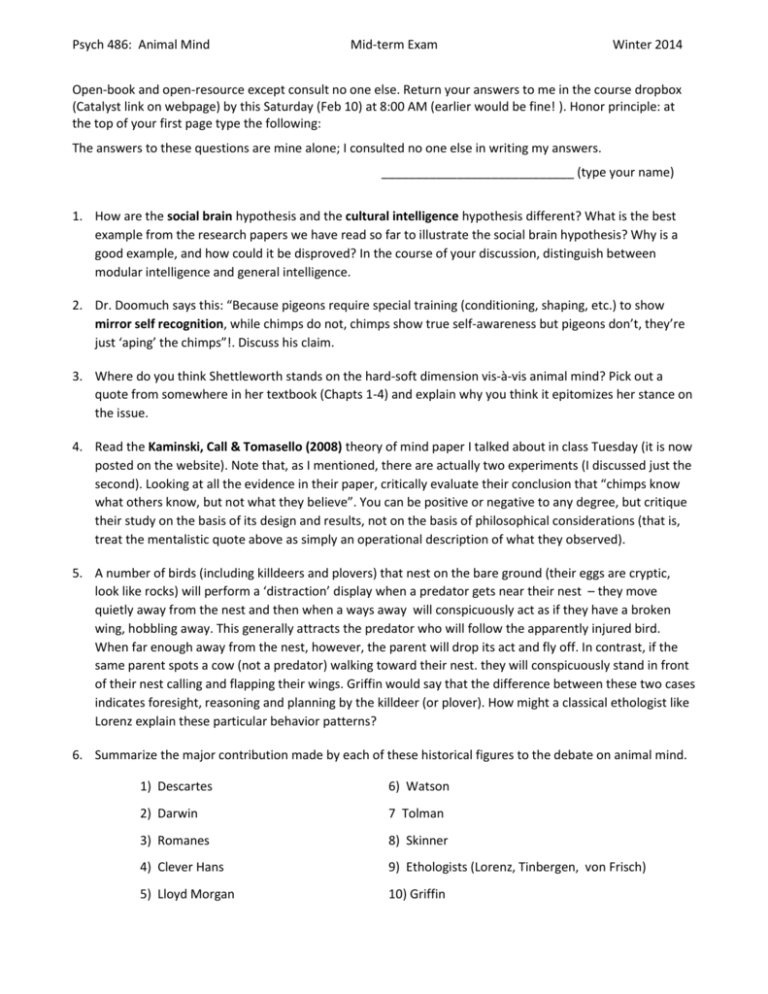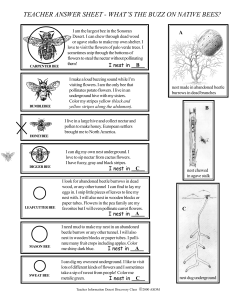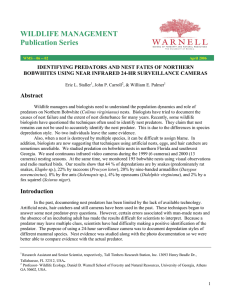EXAM 1
advertisement

Psych 486: Animal Mind Mid-term Exam Winter 2014 Open-book and open-resource except consult no one else. Return your answers to me in the course dropbox (Catalyst link on webpage) by this Saturday (Feb 10) at 8:00 AM (earlier would be fine! ). Honor principle: at the top of your first page type the following: The answers to these questions are mine alone; I consulted no one else in writing my answers. ____________________________ (type your name) 1. How are the social brain hypothesis and the cultural intelligence hypothesis different? What is the best example from the research papers we have read so far to illustrate the social brain hypothesis? Why is a good example, and how could it be disproved? In the course of your discussion, distinguish between modular intelligence and general intelligence. 2. Dr. Doomuch says this: “Because pigeons require special training (conditioning, shaping, etc.) to show mirror self recognition, while chimps do not, chimps show true self-awareness but pigeons don’t, they’re just ‘aping’ the chimps”!. Discuss his claim. 3. Where do you think Shettleworth stands on the hard-soft dimension vis-à-vis animal mind? Pick out a quote from somewhere in her textbook (Chapts 1-4) and explain why you think it epitomizes her stance on the issue. 4. Read the Kaminski, Call & Tomasello (2008) theory of mind paper I talked about in class Tuesday (it is now posted on the website). Note that, as I mentioned, there are actually two experiments (I discussed just the second). Looking at all the evidence in their paper, critically evaluate their conclusion that “chimps know what others know, but not what they believe”. You can be positive or negative to any degree, but critique their study on the basis of its design and results, not on the basis of philosophical considerations (that is, treat the mentalistic quote above as simply an operational description of what they observed). 5. A number of birds (including killdeers and plovers) that nest on the bare ground (their eggs are cryptic, look like rocks) will perform a ‘distraction’ display when a predator gets near their nest – they move quietly away from the nest and then when a ways away will conspicuously act as if they have a broken wing, hobbling away. This generally attracts the predator who will follow the apparently injured bird. When far enough away from the nest, however, the parent will drop its act and fly off. In contrast, if the same parent spots a cow (not a predator) walking toward their nest. they will conspicuously stand in front of their nest calling and flapping their wings. Griffin would say that the difference between these two cases indicates foresight, reasoning and planning by the killdeer (or plover). How might a classical ethologist like Lorenz explain these particular behavior patterns? 6. Summarize the major contribution made by each of these historical figures to the debate on animal mind. 1) Descartes 6) Watson 2) Darwin 7 Tolman 3) Romanes 8) Skinner 4) Clever Hans 9) Ethologists (Lorenz, Tinbergen, von Frisch) 5) Lloyd Morgan 10) Griffin











